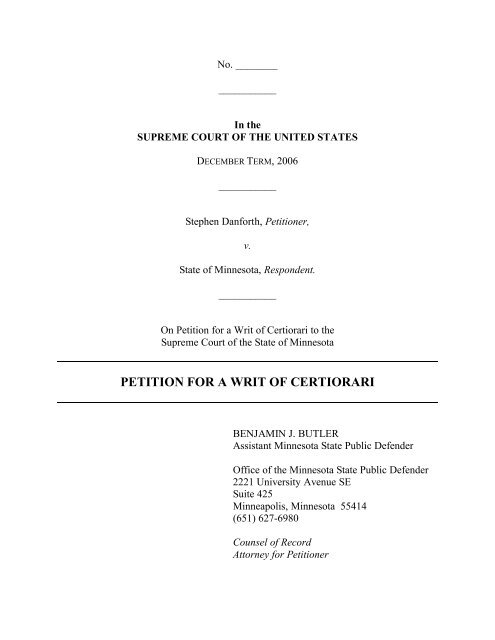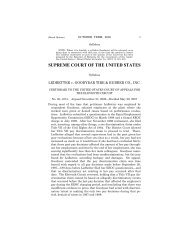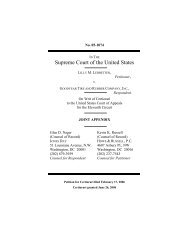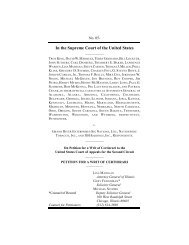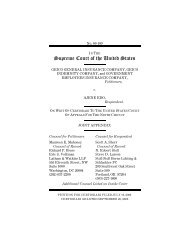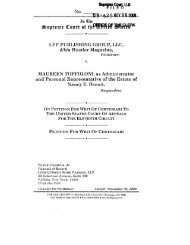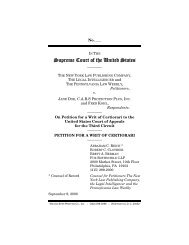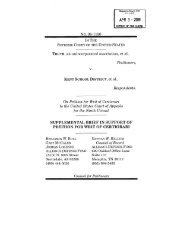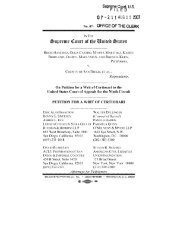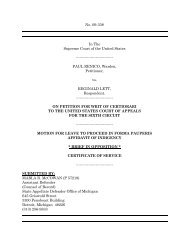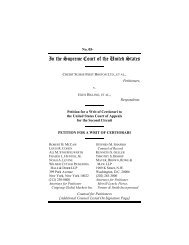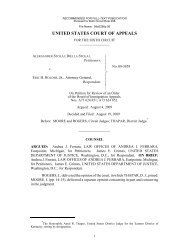PETITION FOR A WRIT OF CERTIORARI - SCOTUSblog
PETITION FOR A WRIT OF CERTIORARI - SCOTUSblog
PETITION FOR A WRIT OF CERTIORARI - SCOTUSblog
You also want an ePaper? Increase the reach of your titles
YUMPU automatically turns print PDFs into web optimized ePapers that Google loves.
No. ________<br />
___________<br />
In the<br />
SUPREME COURT <strong>OF</strong> THE UNITED STATES<br />
DECEMBER TERM, 2006<br />
___________<br />
Stephen Danforth, Petitioner,<br />
v.<br />
State of Minnesota, Respondent.<br />
___________<br />
On Petition for a Writ of Certiorari to the<br />
Supreme Court of the State of Minnesota<br />
<strong>PETITION</strong> <strong>FOR</strong> A <strong>WRIT</strong> <strong>OF</strong> <strong>CERTIORARI</strong><br />
BENJAMIN J. BUTLER<br />
Assistant Minnesota State Public Defender<br />
Office of the Minnesota State Public Defender<br />
2221 University Avenue SE<br />
Suite 425<br />
Minneapolis, Minnesota 55414<br />
(651) 627-6980<br />
Counsel of Record<br />
Attorney for Petitioner
QUESTIONS PRESENTED<br />
1. Are state supreme courts required to use the standard announced in Teague v.<br />
Lane, 489 U.S. 288 (1989), to determine whether United States Supreme Court<br />
decisions apply retroactively to state-court criminal cases, or may a state court<br />
apply state-law- or state-constitution-based retroactivity tests that afford<br />
application of Supreme Court decisions to a broader class of criminal defendants<br />
than the class defined by Teague?<br />
2. Did Crawford v. Washington, 541 U.S. 36 (2004), announce a “new rule of<br />
constitutional criminal procedure,” as Teague defines that phrase and, if it did, was<br />
it a watershed rule of procedure subject to full retroactive application?
IN THE<br />
SUPREME COURT <strong>OF</strong> THE UNITED STATES<br />
____________________________________________<br />
<strong>PETITION</strong> <strong>FOR</strong> <strong>WRIT</strong> <strong>OF</strong> <strong>CERTIORARI</strong><br />
________________________<br />
Petitioner Stephen Danforth respectfully prays that a writ of certiorari issue to<br />
review the judgment below.<br />
OPINION BELOW<br />
The opinion of the Minnesota Supreme Court appears at appendix A to this<br />
petition. The court’s opinion is published at 718 N.W.2d 451 (Minn. 2006).<br />
JURISDICTION<br />
The Minnesota Supreme Court issued its decision on July 27, 2006. A copy is<br />
attached at appendix A. The Minnesota Supreme Court entered final judgment on the<br />
appeal on October 10, 2006. A copy of the judgment is attached at appendix B. The<br />
jurisdiction of this Court is invoked under 28 U.S.C. § 1257(a).<br />
1
U.S. Const. Amend. VI:<br />
CONSTITUTIONAL PROVISIONS<br />
In all criminal prosecutions, the accused shall enjoy the right to a speedy and public trial,<br />
by an impartial jury of the State and district wherein the crime shall have been<br />
committed, which district shall have been previously ascertained by law, and to be<br />
informed of the nature and cause of the accusation; to be confronted with the witnesses<br />
against him; to have compulsory process for obtaining witnesses in his favor, and to have<br />
the Assistance of Counsel for his defense.<br />
U.S. Const. Amend. XIV, sec. 1:<br />
All persons born or naturalized in the United States and subject to the jurisdiction thereof,<br />
are citizens of the United States and of the State wherein they reside. No State shall make<br />
or enforce any law which shall abridge the privileges or immunities of citizens of the<br />
United States; nor shall any State deprive any person of life, liberty, or property, without<br />
due process of law; nor deny to any person within its jurisdiction the equal protection of<br />
the laws.<br />
STATEMENT <strong>OF</strong> THE CASE<br />
Petitioner Stephen Danforth was convicted by a jury in Minneapolis, Hennepin<br />
County, Minnesota, of first-degree criminal sexual conduct, Minn. Stat. § 609.342, subd.<br />
1(a) (1994), on March 6, 1996. (App. A-1). The conviction arose out of the alleged<br />
sexual abuse of J.S., then a six-year-old boy. (Id.). The district court judge found that<br />
J.S. was incompetent to testify at petitioner’s trial. In lieu of live testimony subject to<br />
cross-examination, therefore, the jury saw and heard a videotaped interview of J.S.<br />
conducted at a “non-profit center.” (Id.). During the interview, J.S. accused petitioner<br />
of sexually abusing him. (App. C-3). 1<br />
1 The Minnesota Court of Appeals’ opinion in petitioner’s direct appeal is published at<br />
573 N.W.2d 369 (Minn. Ct. App. 1997), and is attached at appendix C.<br />
2
Petitioner appealed his conviction. Among other claims, he argued that the<br />
admission of the videotape of J.S.’s statement violated his rights under the Confrontation<br />
Clause of the Sixth Amendment to the United States Constitution. (App. C-6). The<br />
Minnesota Court of Appeals considered the issue under the balancing test set forth in<br />
Ohio v. Roberts, 448 U.S. 56 (1980), along with Idaho v. Wright, 497 U.S. 805 (1990),<br />
and attendant Minnesota caselaw. (App. C-6-7). The Court of Appeals affirmed the<br />
admission of the tape and the conviction, holding that “the videotape was sufficiently<br />
reliable to be admitted into evidence.” (Id.). The Minnesota Supreme Court denied<br />
review and, following an appeal after a resentencing, petitioner’s case became final in<br />
1999. 2 In 2004, this Court released Crawford v. Washington, 541 U.S. 36 (2004). In<br />
Crawford, the Court “impose[d] an absolute bar to [the admission of] statements that are<br />
testimonial, absent a prior opportunity to cross-examine [the declarant].” Crawford, 541<br />
U.S. at 62. Believing that the statement at issue in his case was testimonial and thus was<br />
admitted in violation of his right of confrontation, petitioner, acting pro se, filed a second<br />
petition for postconviction relief to challenge his conviction. 3<br />
The district court denied<br />
the petition and the Minnesota Court of Appeals affirmed. Danforth v. State, 700<br />
2 In late 2000, petitioner filed a petition for postconviction relief to challenge his<br />
conviction and sentence. The petition was denied and it is not at issue here. See<br />
Danforth v. State, 2000 WL 1780244 (Minn. Ct. App. 2000), rev. denied (Minn. Feb. 13,<br />
2001) (attached in Appendix E).<br />
3 See Deegan v. State, 711 N.W.2d 89, 93-96 (Minn. 2006) (discussing Minnesota’s<br />
Post-Conviction Relief Act); See Minn. Stat. § 590.01, et seq. (2004) (providing for<br />
petitions for postconviction relief).<br />
3
N.W.2d 530 (Minn. Ct. App. 2005). Petitioner petitioned for further review, and the<br />
Minnesota Supreme Court granted the petition and assigned him counsel. 4<br />
Petitioner encouraged the Minnesota Supreme Court to consider the issue of<br />
Crawford’s application to his case under a standard different from the one used in federal<br />
court to determine whether new rules of constitutional criminal procedure apply<br />
retroactively to cases pending on federal habeas corpus review. (App. A-4); see also<br />
Teague v. Lane, 489 U.S. 288 (1988). Petitioner argued that because the Minnesota<br />
Supreme Court has the authority to offer its citizens greater protections under the state<br />
constitution than those offered by the federal constitution, the court could apply<br />
Crawford to a broader class of cases than the class required by Teague. In the alternative,<br />
petitioner argued that Crawford applied to his case under the Teague standard. (App. A-<br />
4-5).<br />
The Minnesota Supreme Court disagreed with both arguments. The court held<br />
that petitioner “is incorrect when he asserts that state courts are free to give a [United<br />
States] Supreme Court decision of federal constitutional criminal procedure broader<br />
retroactive application than that given by the Supreme Court.” (App. A-5). Citing two of<br />
this Court’s decisions, American Trucking Associations v. Smith, 469 U.S. 167, 178<br />
(1990) (plurality opinion), and Michigan v. Payne, 412 U.S. 47, 49 (1973), as authority,<br />
the Minnesota court held that it “cannot apply state retroactivity principles when<br />
4 During the course of these proceedings, petitioner has had a federal habeas corpus<br />
challenge to his conviction pending. The district court denied the petition but granted<br />
petitioner a certificate of appealability to the United States Court of Appeals for the<br />
Eighth Circuit on the Crawford issue. Danforth v. Crist, 2005 WL 2105502 (D. Minn.<br />
Aug. 26, 2005). The undersigned does not represent petitioner in that process.<br />
4
determining the retroactivity of a new rule of federal constitutional criminal procedure if<br />
the Supreme Court has already provided relevant federal principles.” (App. A-5-6). The<br />
court recognized that several other state supreme courts had reached the opposite<br />
conclusion and noted that the policy concerns underlying Teague may not apply to state<br />
postconviction proceedings. (App. A-6-7). But ultimately, the court held that it was “not<br />
free to fashion [its] own standard of retroactivity for Crawford.” (App. A-7).<br />
Applying Teague, the Minnesota Supreme Court held that Crawford had<br />
announced a new rule of constitutional criminal procedure and that the rule was not a<br />
watershed rule. (App. A-7-14). Therefore, the court held that Crawford did not apply to<br />
petitioner’s case. It affirmed the denial of his post-conviction petition. (App. A-14).<br />
Petitioner now seeks a writ of certiorari from this Court on the two important<br />
questions presented in this case.<br />
5
REASON <strong>FOR</strong> GRANTING THE <strong>PETITION</strong><br />
I.<br />
THE COURT SHOULD GRANT THE <strong>WRIT</strong> TO DECIDE<br />
WHETHER A STATE COURT MUST APPLY THE TEAGUE<br />
STANDARD WHEN DETERMINING THE RETROACTIVE<br />
EFFECT <strong>OF</strong> UNITED STATES SUPREME COURT DECISIONS,<br />
OR WHETHER STATE COURTS MAY USE A BROADER<br />
STANDARD <strong>FOR</strong> RETROACTIVE APPLICATION.<br />
Deepening a split of authority in the state courts, the Minnesota Supreme Court<br />
held that it was absolutely prohibited from applying any test for retroactive application of<br />
new rules of federal constitutional criminal procedure other than the test announced in<br />
Teague v. Lane, 489 U.S. 288, 310 (1989). This Court should grant certiorari in this case<br />
because this important issue, a question of federal law, is subject to an intractable split of<br />
authority in the lower courts and it has not been, but should be, resolved by this Court.<br />
U.S. Sup. Ct. Rule 10.<br />
A. The Teague Standard Is Based on Principles Unique to State Cases<br />
Being Considered Under Federal Habeas Corpus Review.<br />
In Teague v. Lane and subsequent decisions, this Court announced and applied a<br />
test for determining whether the holding of one of this Court’s cases could be applied<br />
retroactively to cases pending on federal habeas corpus review. This Court recently<br />
summarized the test as follows:<br />
Under Teague, the determination whether a constitutional rule of criminal<br />
procedure applies to a case on collateral review involves a three-step<br />
process. First, the court must determine when the defendant's conviction<br />
became final. Second, it must ascertain the legal landscape as it then<br />
existed, and ask whether the Constitution, as interpreted by the precedent<br />
then existing, compels the rule. That is, the court must decide whether the<br />
rule is actually new. Finally, if the rule is new, the court must consider<br />
whether it falls within either of the two exceptions to nonretroactivity.<br />
6
Beard v. Banks, 542 U.S. 406, 411 (2004) (citations omitted).<br />
In Teague, the Supreme Court, instead of focusing on the purpose and<br />
impact of a new constitutional rule, looked to the function of federal habeas<br />
review, which is to ensure that state courts conscientiously follow federal<br />
constitutional standards. The Court determined that this function is met by<br />
testing state convictions against the constitutional law recognized at the<br />
time of trial and direct appellate review,…[.] Therefore, once a conviction<br />
has become final, federal courts should generally not interfere with the state<br />
courts by applying new rules retroactively.<br />
Colwell v. State, 59 P.3d 463, 470 (Nev. 2002) (citations omitted). The Teague Court<br />
based the test upon its conclusion that “the interests of comity and finality” precluded a<br />
federal court from altering a state court conviction based upon a newly announced rule of<br />
federal constitutional law. Teague, 489 U.S. at 308. The Court was also concerned with<br />
the “costs imposed upon the States by retroactive application of new rules of<br />
constitutional law on habeas corpus.” Id. at 310 (quotation omitted). Finally, the Court<br />
recognized that “‘[s]tate courts are understandably frustrated when they faithfully apply<br />
existing constitutional law only to have a federal court discover, during a [habeas]<br />
proceeding, new constitutional commands.” Id. (quoting Engle v. Isaac, 456 U.S. 108,<br />
128 n. 33 (1982)).<br />
B. There is a split of authority over whether state courts are required<br />
to use the Teague standard or whether they are free to fashion their<br />
own broader test retroactive application of United States Supreme<br />
Court decisions.<br />
Given that the reasons behind the Teague test apply primarily, if not exclusively,<br />
to federal habeas corpus cases, many state courts have declined to use the Teague<br />
standard and instead have considered the retroactive effect of this Court’s holdings under<br />
their own, broader tests. See Smart v. State, ___ P.3d ___, 2006 WL 3042821 (Alaska<br />
7
App. Oct. 27, 2006); Hughes v. State, 901 So.2d 837, 839-48 (Fla. 2004); State v.<br />
Whitfield, 107 S.W.3d 253, 266-68 (Mo. 2003); Colwell v. State, 59 P.3d 463, 470-71<br />
(Nev. 2002), cert. denied, 540 U.S. 981 (2003); State ex rel. Taylor v. Whitley, 606 So.2d<br />
1292, 1296-97 (La. 1992), cert. denied 508 U.S. 962 (1993); Daniels v. State, 561 N.E.2d<br />
487, 489 (Ind. 1990); Cowell v. Leapley, 458 N.W.2d 514, 517-18 (S.D. 1990); see also<br />
State v. Forbes, 119 P.3d 144, 148-49 (N.M. 2005) (holding that Crawford did not<br />
announce a new rule but only as applied to defendant at issue, who had argued for<br />
Crawford’s definition of “testimonial” on direct appeal); Hon. Laura Denvir Stith, A<br />
Contrast of State and Federal Court Authority to Grant Habeas Relief, 38 Val. U. L. Rev.<br />
421, 438-49 (2004) (arguing that states are free to use retroactivity standards other than<br />
Teague to afford retroactive application of United States Supreme Court decisions to<br />
boarder class of defendants). As authority for their holdings, many of those courts relied<br />
upon this Court’s pre-Teague statement that states are “entirely free to effectuate under<br />
their own law stricter standards than those we have laid down and to apply those<br />
standards in a broader range of cases than is required by” the Supreme Court’s<br />
interpretation of the federal constitution. 5 Johnson v. New Jersey, 384 U.S. 719, 733<br />
(1966).<br />
In addition, these courts rely upon the longstanding rule that state courts are<br />
permitted to interpret their state constitutions to provide greater freedoms to their citizens<br />
than those provided by the federal constitutions. See Michigan v. Long, 463 U.S. 1032,<br />
1040 (1983); see also Brigham City, Utah v. Stewart, 547 U.S. ___, ___, 126 S.Ct. 1943,<br />
5 See, e.g., Colwell, 59 P.3d at 470-72; State v. Fair, 502 P.2d 1150, 1151 (Or. 1972),<br />
overruled by Page v. Palmateer, 84 P.3d 133, 138 (Or. 2002).<br />
8
1950-51 (2006) (Stevens, J., concurring) (discussing state supreme court’s authority to<br />
provide greater protections under state constitution than those afforded by federal<br />
constitution). Part of that freedom, the courts cited above have concluded, is the freedom<br />
to provide relief to a larger class of criminal defendants than that required by Teague.<br />
See, e.g. Colwell, 59 P.3d at 470 (rejecting Teague standard because “Teague is not<br />
controlling on this court, other than in the minimum constitutional protections established<br />
by its two exceptions.”); State v. Fair, 502 P.2d 1150, 1152 (Or. 1972) (holding that state<br />
courts “are free to choose the degree of retroactivity or prospectivity which we believe<br />
appropriate to the particular rule under consideration, so long as we give federal<br />
constitutional rights at least as broad a scope as the United States Supreme Court<br />
requires”), overruled by Page v. Palmateer, 84 P.3d 133, 138 (Or. 2004), cert. denied,<br />
543 U.S. 866 (2004).<br />
Other state courts, now including the Minnesota Supreme Court, have concluded<br />
that they do not have the authority to use a broader test for retroactive application of this<br />
court’s decisions. (App. A-5-7); Page v. Palmateer, 84 P.3d 133, 137-38 (Or. 2004);<br />
State v. Egelhoff, 900 P.2d 260, 267 (Mont. 1995). Those courts have relied upon this<br />
Court’s decisions in American Trucking Associations, Inc. v. Smith, 496 U.S. 167 (1990),<br />
Oregon v. Hass, 420 U.S. 714, 719 (1975), and Michigan v. Payne, 412 U.S. 47 (1973),<br />
for the proposition that they “cannot apply state retroactivity principles when determining<br />
the retroactivity of a new rule of federal constitutional criminal procedure if the Supreme<br />
Court has already provided relevant federal principles.” (App A-5-6); see also Page, 84<br />
P.3d at 137-38 (distinguishing between rules of state and federal constitutional law and<br />
9
holding that it was not “free to determine the degree to which a new rule of federal<br />
constitutional law should be applied retroactively”). These courts did not simply decide<br />
to apply the Teague standard as a matter of comity or policy. 6<br />
Instead, they held that<br />
they were forced by this court’s decisions to apply Teague. (App. A5-7); Page, 84 P.3d<br />
at 138.<br />
The split of authority on this issue is large and intractable. The issue of whether a<br />
state court must use the Teague standard has been decided different ways by courts in no<br />
fewer than twelve states. Only the United States Supreme Court can resolve this issue.<br />
The question of whether state-courts are required to use the Teague standard to determine<br />
the retroactive effect of Supreme Court decisions in state courts is a question of federal<br />
law. See American Trucking, 496 U.S. at 177-78. But the lower federal courts are<br />
unlikely to be in a position to resolve this question, thanks to the numerous procedural<br />
and substantive barriers surrounding federal habeas corpus petitions. The most daunting<br />
such barrier is the requirement that any state-court decision must be “contrary to, or<br />
involved an unreasonable application of, clearly established federal law, as determined by<br />
the Supreme Court of the United States,” before habeas relief can be granted. 28 U.S.C.<br />
§ 2254(d)(1) (2005). This Court has never decided the question of whether state courts<br />
are bound to apply Teague and state courts can find support in this Court’s caselaw for<br />
the proposition that they are and are not so bound. It is highly unlikely, therefore, that a<br />
federal court sitting in judgment of a habeas petition can resolve this issue.<br />
6 Indeed, the Minnesota court recognized that the Teague standard was based upon<br />
“different policy concerns” than those facing state-court judges reviewing state-court<br />
decisions, but nonetheless held that it was compelled to follow Teague. (App. A-6-7).<br />
10
At least one state supreme court has already used its perceived power to amend the<br />
standard of retroactive application to afford greater protections to one of its citizens on<br />
this very issue – the retroactivity of Crawford. The New Mexico Supreme Court held<br />
that Crawford applied retroactively to a case that became final in 1987. Forbes, 119 P.3d<br />
at 147-49. 7<br />
In the mid-1980s, the New Mexico court had agreed with the defendant,<br />
Ralph Earnest, that testimonial hearsay was inadmissible in criminal trials, only to be<br />
reversed by this Court. Forbes, 119 P.3d at 146. In Forbes, the New Mexico court held<br />
that Crawford did not announce a “new rule” when applied to the case before it. The<br />
court so held for equitable reasons:<br />
Our decision is limited to the very special facts of this case, highlighted by<br />
the fact that the very law this Court applied to Earnest’s case twenty years<br />
ago has now been vindicated, which entitles him to the same new trial he<br />
should have received back then.<br />
Id. at 148-49; see also Id. at 146 (“It is beyond dispute that since Crawford, the rest of the<br />
nation knows now what the New Mexico Supreme Court announced in 1985”).<br />
The decision in Forbes, in which a state supreme court awarded retroactive<br />
application to a criminal defendant of a United States Supreme Court decision as a matter<br />
of equity, cannot be squared with the Minnesota Supreme Court’s holding in this case:<br />
that state courts are not free to apply any retroactivity standard other than Teague to<br />
United States Supreme Court decisions. If the supreme courts of Minnesota, Oregon, and<br />
Montana are correct, and a state court has no authority to apply state retroactivity<br />
principles to Supreme Court decisions on federal constitutional rights, then the New<br />
7 A petition for writ of certiorari in Forbes is pending before this Court. See New Mexico<br />
v. Forbes, U.S. Sup. Ct. File No. 05-644.<br />
11
Mexico court’s decision in Forbes is wrong. But if, on the other hand, state courts are<br />
“free to effectuate under their own law [broader retroactivity standards and to] apply<br />
those standards in a broader range of cases than is required by” Teague, Johnson 384<br />
U.S. at 733, then the New Mexico court’s decision in Forbes is justifiable, and the<br />
Minnesota Supreme Court’s decision in this case is not. Either the New Mexico Supreme<br />
Court overstepped its bounds or the Minnesota Supreme Court unnecessarily constrained<br />
itself. This Court should accept certiorari over this case to determine which is correct.<br />
The only way for the split of authority on this important issue to be resolved is for<br />
this Court to resolve it. This Court should accept certiorari over this case to resolve the<br />
split of lower-court authority on this important issue.<br />
C. The question of whether state courts are bound to apply Teague is<br />
vitally important to every state court in the country.<br />
The question of whether a state supreme court is bound to apply the Teague test is<br />
a vitally important question of federal law, the answer to which will affect every state<br />
court in the country. Each term, this Court issues numerous criminal-law decisions, each<br />
one potentially affecting innumerable criminal prosecutions in this country. State courts,<br />
in which the vast majority of such prosecutions are based, need to know by which<br />
decisions they are bound and, alternatively, how much power they have to provide<br />
greater protections to their citizens than the protections afforded by the federal<br />
constitution. This Court has always shown “[r]espect for the independence of state<br />
courts,” and has recognized that “[i]t is fundamental that state courts be left free and<br />
unfettered by [this Court] in interpreting their state constitutions.” Long, 463 U.S. at<br />
1040-41. The Court should accept certiorari over this case to ensure that state courts are,<br />
12
indeed, “free and unfettered” to apply this Court’s decisions “in a broader range of cases<br />
than is required by” Teague. Id.; Johnson, 384 U.S. at 733. Right now, at least two<br />
states do not feel so free or so unfettered.<br />
In addition, this Court should accept certiorari over this case to resolve any<br />
inconsistencies in its own caselaw. The state courts that have concluded that they are free<br />
to fashion their own retroactivity standards have relied on one line of cases from this<br />
Court; a line that includes Johnson and Long and stands for the proposition that state<br />
supreme courts are free to interpret their own constitutions in ways that give greater<br />
protections to their citizens than those afforded by the federal constitution. Other state<br />
supreme courts, including the Minnesota Supreme Court in this case, have relied upon a<br />
line of cases that include American Trucking, Payne, and Hass; cases that stand for the<br />
proposition that the retroactive effect of this Court’s decisions involve only questions of<br />
federal law, not state law, and that state law does not apply.<br />
If the latter were true, however, one would think that claim that an issue was<br />
Teague-barred would be nonwaivable. But this Court has repeatedly held that the Teague<br />
rule simply created a procedural defense that state governments might raise in a habeas<br />
proceeding that this defense was forfeited if the state did not raise it in a timely manner.<br />
See Schiro v. Farley, 510 U.S. 222, 228-29 (1994) (noting that state did not assert Teague<br />
as a defense in a timely manner); Godinez v. Moran, 509 U.S. 389, 397 n. 8 (1993)<br />
(same); see also Collins v. Youngblood, 497 U.S. 37, 41 (1990) (holding that Teague rule<br />
is not “jurisdictional” and accepting state’s waiver of any Teague issue). Only this Court<br />
13
can resolve any inconsistencies between these two lines of cases, and it should do so by<br />
accepting certiorari over this case.<br />
The Minnesota Supreme Court, and the other state supreme courts in the minority,<br />
have held that this Court’s decisions have bound them to use the Teague standard when<br />
deciding whether to apply federal constitutional rules retroactively. But what happens if<br />
this Court holds that Congress can, or has, abrogated Teague altogether? In at least two<br />
cases this term, this Court is considering whether amendments to the federal habeas<br />
stature, 28 U.S.C. § 2254(d)(1) and (2), effectively abrogated the Teague standards. See<br />
Wharton v. Bockting, Sup. Ct. File No. 05-595; Burton v. Stewart, Sup. Ct. File No. 05-<br />
9222. If Teague is binding upon the states, and Congress can abrogate Teague, then can<br />
Congress prohibit state courts from applying United States Supreme Court decisions<br />
retroactively? Or, if Congress has abrogated Teague, has it already done so? The Court<br />
should grant certiorari over this case to answer these important questions.<br />
Finally, this Court should grant certiorari in the interests of justice. This Court has<br />
granted certiorari in a number of cases to, in Justice Stevens’ words, “make sure that<br />
a State’s highest court has not granted its citizens any greater<br />
protection than the bare minimum required by the Federal<br />
Constitution.” Washington v. Recuenco, 126 S.Ct. 2546, 2554 (2006)<br />
(Stevens, J., dissenting) (citing Brigham City, 547 U.S. ___, 126 S.Ct.<br />
1943 (2006); Kansas v. Marsh, 548 U.S. ___, 126 S.Ct. 2516 (2006)).<br />
The issue presented here dovetails with Justice Stevens’ concerns. In<br />
this case the Minnesota Supreme Court held that it could not “grant[]<br />
14
its citizens any greater protection than the bare minimum required by”<br />
Teague. Recuenco, 126 S.Ct. at 2554 (Stevens, J., dissenting); (App.<br />
A-6-7). This Court should make sure that state supreme courts know<br />
to what extent they are free to interpret their own constitutions to<br />
provide greater protections to their citizens.<br />
The primary purpose behind Teague was “to limit the scope of<br />
federal habeas corpus review of state criminal convictions.” Id. at<br />
*13. It was not “to achieve uniformity of results among the fifty<br />
states.” Id.; see also Mary C. Hutton, Retroactivity in the States: The<br />
Impact of Teague v. Lane on State Postconviction Remedies, 44 Ala. L.<br />
Rev. 421, 449-58 (1993) (arguing that states should follow broader<br />
retroactively principles than those announced in Teague; describing<br />
notion that states are bound to follow Teague as “mistaken”). The<br />
Teague standard was not designed for state courts, and it was<br />
certainly not designed to bind state courts. The Court should grant the<br />
petition for writ of certiorari on this issue.<br />
15
II.<br />
THIS COURT SHOULD GRANT THE <strong>WRIT</strong> TO DETERMINE IF<br />
CRAW<strong>FOR</strong>D’S HOLDING APPLIES TO <strong>PETITION</strong>ER’S CASE,<br />
THE IDENTICAL ISSUE PRESENTED IN THE PENDING CASE<br />
<strong>OF</strong> WHORTON v. BOCKTING.<br />
The Minnesota Supreme Court affirmed petitioner’s conviction because it held<br />
that Crawford, which was decided in 2004, did not apply to petitioner’s case, which<br />
became final in September 1999. The Minnesota court considered the issue of<br />
Crawford’s retroactive application under the Teague standard and held that 1) Crawford<br />
had announced a new rule of constitutional criminal procedure; and 2) the rule was not a<br />
watershed rule. (App. A-7-14).<br />
In 2004, a split panel of the United States Circuit Court of Appeals for the Ninth<br />
Circuit reached the opposite conclusion. Bockting v. Bayer, 399 F.3d 1010 (9th Cir.<br />
2004), op. amended, re’hrg en banc denied 408 F.3d 1127 (9th Cir. 2005). Considering<br />
the same issue, a majority of the panel held that, even if Crawford had announced a new<br />
rule, it was a watershed rule of criminal procedure and was fully retroactive. Bockting,<br />
399 F.3d at 1018. One of the panelists would have concluded that Crawford did not<br />
announce a new rule and therefore applied to all past cases. Bockting, 399 F.3d at 1022-<br />
24 (Noonan, J., concurring). Another panelist dissented and would have held that<br />
Crawford announced a new rule but not a watershed rule of procedure. Id. at 1024-41<br />
(Wallace, J., dissenting).<br />
This Court has issued a writ of certiorari in Bockting, presumably to determine<br />
(possibly among other things) Crawford’s retroactive effect under the Teague standard.<br />
Whorton v. Bockting, ___ U.S. ___, 126 S.Ct. 2017 (2006) (mem) (U.S. Supreme Court<br />
16
File No. 05-595). Because Minnesota feels compelled to use the Teague standard to<br />
determine the retroactive effect of Crawford and this Court’s other decisions, the decision<br />
in Bockting could control the outcome of petitioner’s case. Only by granting this petition<br />
can the Court assure that petitioner will benefit from its ruling. As an alternative to<br />
granting the petition on the merits of the first issue presented, this Court should grant the<br />
petition and consider staying any further proceedings until it renders a decision in<br />
Bockting.<br />
17
CONCLUSION<br />
The petition for a writ of certiorari should be granted.<br />
Respectfully submitted,<br />
Benjamin J. Butler<br />
Assistant Minnesota State Public Defender<br />
Office of the Minnesota State Public Defender<br />
2221 University Avenue SE<br />
Suite 425<br />
Minneapolis, Minnesota 55414<br />
(612) 627-6980<br />
Counsel of Record<br />
Attorney for Petitioner<br />
18
INDEX TO APPENDICES<br />
APPENDIX A: Opinion of the Minnesota Supreme Court A-1<br />
APPENDIX B: Appellate court judgment B-1<br />
APPENDIX C: State v. Danforth, 573 N.W.2d 369<br />
(Minn. Ct. App. 1997) C-1<br />
Page<br />
APPENDIX D:<br />
APPENDIX E:<br />
APPENDIX F:<br />
State v. Danforth, 1999 WL 262143 (Minn. Ct. App.<br />
May 4, 1999), rev. denied (Minn. July 28, 1999) D-1<br />
Danforth v. State, 2000 WL 1780244 (Minn. Ct. App.<br />
Dec. 5, 2000), rev. denied (Minn. Feb. 13, 2001) E-1<br />
Danforth v. Crist, 2005 WL 2105502 (D. Minn.<br />
Aug. 26, 2005) F-1<br />
19


